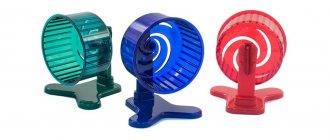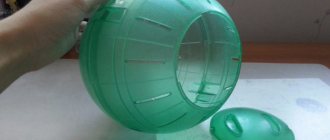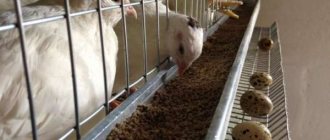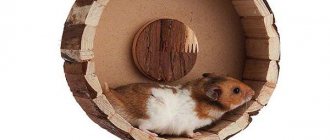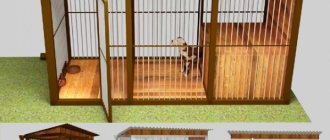- home
- Housing
11/20/2018 A maze for a hamster is a kind of exciting game for logic, intelligence and resourcefulness. The original attraction also plays the role of a simulator, like a running wheel - while the hamster wanders through the corridors of the labyrinth, it stretches its legs no worse than in a wheel. So that the rodent does not get bored and his leisure time is interesting and useful, it is worth providing him with such a toy. You can purchase a ready-made labyrinth at a pet store, but even better is to make an entertainment complex for the animal yourself. Then the pet will have a unique toy designed specifically for him. This is not difficult to do, but your pet’s joy will know no bounds.
Ready-made hamster cage with tunnels
You can purchase a cage equipped with tunnels at almost any large pet store.
The price for a regular cage starts from 1.5 – 2.0 thousand rubles. Tunnels add to the cost of the cell from 500 to 2.5 thousand rubles. So the FerplastLauraDecor cage costs from 3900 rubles. up to 4500, depending on the store. In this case, a separate pipe can be purchased inexpensively. On average, one tunnel link costs a little more than 200 rubles, and sometimes even cheaper. So Ferplast Pipe-bend can be bought for 184 rubles.
Tunnels and labyrinths are very important for small animals, which in nature travel long distances in search of food. In captivity, rodents are provided with food, but they need to move around quite a lot. One wheel is not enough. Labyrinths equipped with obstacles, ladders and bridges, and tunnels simulating holes and passages will help animals maintain health.
From plastic bottles
It’s worth saying right away that building a maze for a hamster from plastic bottles is more difficult than from a construction set - here a child cannot do without the help of an adult.
To work, you will need a sharp utility knife and plastic bottles. Their number can be either half a dozen or fifty. The more bottles, the longer and more interesting the labyrinth you can build.
If a hamster can be released into the labyrinths described above only under the supervision of the owner, then he can spend whole days in the bottle labyrinth. Perhaps he will be no less comfortable here than in his usual cage. And there will be much more space for physical exercise. True, a large labyrinth will take up quite a lot of space - also take this into account when starting work.
Having a sufficient amount of material, you can begin construction:
- Take two bottles. In one of them, on opposite walls, make two holes - a large one and a small one. One should correspond to the diameter of the bottle neck, and the second should correspond to the diameter of the bottle.
- Also make a hole near the neck of the second bottle so that the hamster can easily crawl through. Carefully process the edges - there should be no burrs or sharp surfaces here so that the rodent does not get injured during play.
- From the second bottle, unscrew the cap and insert the neck through the large hole, and then through the small one.
- Replace the cap of the second bottle.
Now you have a short maze consisting of two bottles. A hamster placed in one of them will be able to freely make its way into the second; all that remains is to lengthen the labyrinth to the size that seems optimal to you.
When making a labyrinth from plastic bottles, do not forget to make at least several holes in each bottle - it is best to use a thick awl or a hot nail here. Thanks to these holes, the air will be renewed, and your hamster will definitely not suffocate during his morning run.
You can create several spacious areas in the maze using five-liter water bottles. Place a small wheel in one, equip a drinking bowl and feeder in another, a house in the third, and so on. As a result, you will get not just a homemade maze for your hamster, but a full-fledged house with a treadmill.
Making complex adventure games
Young children will not be able to make complex tunnels for hamsters with their own hands; they will definitely need the help of adults. But teenage boys will cope with the task with a bang!
Tunnel made of plastic bottles
Plastic soda and juice bottles are found in every home. But not everyone knows that they can be used to make a tunnel for a hamster. For this purpose, containers with a volume of 0.5 liters are better suited. If the rodent cage is the place where the tunnel will lie, then only 3-4 bottles will be needed. For an external attraction, you can choose any quantity. All bottles should first be freed from labels and washed thoroughly so that they do not smell.
When building a bottle attraction, follow the plan below:
- Trim the top and bottom to create a cylinder. A stationery knife is better suited for this purpose.
- There will be sharp burrs on the bases of the cylinder, which can injure the fluffy, so they must be masked. To do this, cover the sections with electrical tape.
- Cut round holes in two cylinders of equal diameter. It is important that the size of the circle matches the diameter of the bottle you will attach to it. Cover the edges with electrical tape.
- Now prepare the parts that will act as branches. One of the ends of the bottle must be squeezed and the corners cut off at a slight angle. When you release the bottle, it will straighten out, and the cut will acquire two smooth notches, thanks to which the part will fit tightly to the cylinder with the hole. We do the same with the second bottle. Don't forget to tape the edges!
- Now it's time to make 2 T-shaped connections. Place a bottle with a wavy edge against the hole in the cylinder, wrap the connection with electrical tape, and then wrap the supporting part. To make the structure more durable, repeat this operation twice.
- Now fasten the T-shaped connections together with the same electrical tape. The bottle maze is ready to use!
Important! If you are going to build a long tunnel using this method, then make branches more often. This is necessary for air circulation.
Wooden labyrinth
If you are patient and careful and have woodworking skills, try making a hamster tunnel with your own hands from wood. Sanded boards or plywood are suitable for this purpose. This attraction is safe for hamsters; they will happily run along the intricate passages.
A wooden tunnel can be made large in order to play with animals there and organize hamster races. If cage space allows, install a three-tier wooden labyrinth for your pets. Of course, you will have to work hard cutting out windows and stairs, but your pet will be happy. When creating such a small attraction, it is better to use special wood glue rather than nails.
Now you know how to make a tunnel for a hamster with your own hands, using available materials that are always at hand. By building a room with partitions for your touching furry, you can not only play with him, but also develop your pet’s intelligence.
A little about ferrets
Recently, more and more often animal lovers choose a ferret as a pet. This animal is very funny, cute and to some extent exotic. And this choice is quite logical. Firstly, ferrets are very cheerful creatures, you won’t get bored with them, there is no end in sight to the games and fun. Secondly, the ferrets are very compact, for some this is a significant advantage, since they can be very easily transported on various trips.
Ferrets, despite the fact that they are nocturnal animals, can quite easily adapt to the life rhythm of their owner. There is no need for daily walks with these animals, like, for example, with dogs. If you decide to take your ferret for a walk, getting him accustomed to a harness won’t cause much trouble. They treat the owner friendly, get used to it well, unlike cats, but without fanaticism, like dogs. It is also worth noting that ferrets are distinguished by their extraordinary inquisitiveness of mind, intelligence and cunning.
Among representatives of the same species, you can find animals with completely different manifestations of character, therefore, you can choose a more suitable type for yourself, from super active to calmer.
Subtleties of playing with a rodent
It will be easier for your animal to get to know a new play space if there is a fragrant reward waiting for him inside. Place treats in one compartment to motivate you to travel.
Don't be surprised if the hamster takes a liking to one gallery and stays there for a long time. This means that he mistook it for a winter quarters.
Do not leave your pet unattended, because the nimble animal can run away, chew through the playground material, or even set up a toilet in one of the parts of the maze. After playing, when the hamster runs around and gets tired, return it to the cage, and clean and dry the play area .
Use your imagination, make intricate playgrounds for your pets , replace some tunnels with others, build and modify them. Involve children - their lively mind and creative approach to finding parts for the maze will surprise even experienced designers and craftsmen.
What can you do for your pet yourself?
The hamster is an extremely versatile pet, since it does not require too much space to keep it, and entertainment devices can easily be constructed from what is found in every home. So what should we make ourselves?
- Cell. Build with your own hands both a temporary and permanent home for the rodent. All you need is wooden rods for the frame, plywood for the bottom and a metal mesh, preferably small, so that the baby doesn’t run away on housewarming day.
- Drinking bowl. At first, a plastic bottle and the body of a ballpoint pen can easily cope with the task of such a device.
- House. To build such a structure, almost anything your imagination desires is suitable: from a plastic box to a clay vessel.
- Homemade toys and accessories for “sports” for hamsters. There are no restrictions. Make anything you want that fits in your hamster's apartment.
Of course, the list is far from complete. Make whatever you want. The main thing: do not forget that the devices should not harm the fluffy.
How to make a tunnel for a hamster with your own hands
You can buy tunnels at a pet store or make your own. What are these structures made of:
- plastic bottles;
- toilet paper rolls;
- boxes;
- plumbing pipes.
The choice depends on the size of the animal, the materials at hand and the flight of fancy.
Tunnels for hamsters made from plastic bottles
The advantages of such structures include their safety and accessibility. Food grade plastic bottles of 1.5 and 2 liters are perfect for homemade tunnels. The choice of volume depends on the size of the hamster: 1.5 liters is enough for a Djungarian hamster, a 2 liter bottle is required for a Syrian.
To work you need a stationery knife, scissors and electrical tape. The design consists of identical nodes arranged in random order. Each node consists of two bottles, one of which “pierces” the other at a right angle. Take two bottles:
Cut two holes in one of them just below the neck. One should be small, the neck of the second bottle will fit into it, and the other should be larger, the wide part will be attached there.
Make a hole in the second bottle through which the hamster will get into it from the first.
“Pull” the second bottle through the first so that only the neck goes through.
Place the cap on the neck and screw it on. The result was a knot of two connected bottles. Make the second knot from the second and another - third bottle. Make two holes for fastening the third bottle, stepping back slightly from the bottom of the second bottle. And then, just like the first node.
Connect the lower parts 2 and 3 of the bottle with any number of nodes in any direction. In the middle of the first bottle, make an entrance for the hamsters, attach a bottle cut in half to it.
Cover the cut edges with electrical tape to prevent the animals from getting hurt. In the middle of the resulting funnel, cut two holes for the animals to pass in both directions.
You can also make tunnels for animals from colored bottles, especially if the animals are shy. Animals cannot be left alone in these structures. They can loosen or chew through the walls or suffocate in tightly closed bottles.
Hamster tunnel made from toilet paper boxes and rolls
This design is suitable for small hamsters; a large Syrian will not fit through the toilet paper roller, or it will be very inconvenient for him. Therefore, we focus on Djungarians and other kids. Such tunnels can be made in two ways: using only rollers or rollers and boxes. In the first case, you need to cut holes in the rollers and insert one into the other, as shown in the picture. These nodes then need to be connected to each other in any order.
In the second case, glue the rollers into small boxes with non-toxic glue. To do this, you first need to cut a hole in the wall of the box the width of the roll, insert the roller there and secure it with glue.
Since these passages are made of cardboard, make sure that the hamsters do not eat their way out into them.
Pipe structures
Plastic pipes for hamsters are a real godsend. They are non-toxic and have threads ready for connection. The sizes can be chosen arbitrarily, and their curves are the most intricate. Gray, transparent and white corrugated pipes are perfect for animals. From all this you can create an unusual tunnel. Don't forget to make holes for the animals to breathe in your homemade labyrinth.
Hamster tunnel made from toilet paper boxes and rolls
This structure is suitable only for tiny breeds - dzhungarika and others. Larger animals simply will not fit into the corridor from a toilet paper roll. The design with cardboard boxes is simple. Holes are made in small boxes where rollers are attached, acting as connecting passages between the boxes.
The structure of the structure is arbitrary. If there are no boxes, you can make a maze using only rollers. A through opening is made in the center of the tube, then the same one is cut out in the second one, after which they are threaded into one another. It turns out to be a kind of cross. The procedure is repeated until the tubes run out, then the crosses are randomly connected. The labyrinth is ready.
You can use rollers not only from toilet paper, but also from other products - even tape.
Cardboard labyrinth
Of course, the simplest option is to make mazes for hamsters from cardboard. All you need to get started is:
- two large cardboard boxes (can be purchased at any grocery store);
- scotch,
- non-toxic glue,
- scissors.
Having all these tools and materials, you can safely get to work.
One of the boxes will serve as the base and room for the labyrinth. The other should be cut into long strips no less than 10-15 centimeters high. It is advisable to think through the structure of the future labyrinth in advance and draw it on paper. Make a long tunnel with the maximum number of intersections and dead ends - then it will be more interesting for the hamster to run through it, and the audience will have much more fun.
Hamster maze made of cardboard
Now all that remains is to put the labyrinth into practice - glue the resulting strips using tape and glue. Make sure that they are held firmly, otherwise a curious hamster, trying to climb on them, will simply destroy the entire toy.
All that remains is to place the hamster’s favorite treat in different places and you can launch the main participant into the maze to see how quickly he runs through the narrow passages.
As you can see, making a maze for a hamster out of a box is very easy and simple, and the financial investment is close to zero.
Labyrinth for hamsters from a construction set
If you have Lego at home, it won’t be difficult to make an entertainment area out of it. Here the child will not only help, but also do most of the work. Unlike boxes, Lego does not require additional decoration, and it will not be easy to eat. Using the construction set, you can build a real obstacle course for hamsters, make arches and towers.
Single-story or multi-story: what to choose?
The classic option is a one-story metal cage. It is easy to disassemble, convenient and quick to clean. This design can be additionally equipped with a tunnel or pen: the dwarf will have more room to run.
The second option is a cage of several floors. For such a house there are a number of additional requirements.
Cparks/Pixabay
The distance between floors is from 17 to 25 cm. If the height is more than 30 cm, the level of injury risk increases.
The floor must be solid plastic, since food, bedding and the rodent’s paws will fall through the grate when running
Please note that the cages have height-adjustable tiers.
So which option is better? It is recommended that Djungarian hamsters choose single-story cages with a large area. Individuals love jogging and free space. This is much more interesting for them than climbing or climbing up bars.
What should the tunnels be like?
Whether you buy ready-made hamster tunnels or create them yourself, it is important to take a few details into account. The structure should not have too high (steep) descents and ascents, otherwise the animal has every chance of getting injured
The structure should not have too high (steep) descents or ascents, otherwise the animal has every chance of getting injured.
The tunnel must have space and ventilation. This is necessary in case your pet starts playing and stays in the tunnel for a long time. Entertainment should not be accompanied by inconvenience and discomfort. And even more so, the hamster should not suffocate during its journey. Air holes must be made before presenting the toy to the hamster.
It is important to control that the animal does not chew on the structural elements, regardless of whether they are cardboard or plastic - the attraction must be beneficial. At the end of any maze (and, if possible, at different stages of the hamster’s path), you must put a treat for the little tracker
The animal’s house should not contain a pile of numerous tunnel pipes. The pet needs a spacious room
It is important to provide him with this, without forcing him to huddle in the corner of the cage. The pet should feel love and care - this will evoke reciprocal feelings in him and prolong his life
And the last thing concerns homemade structures. Glue should be used only non-toxic types, without odor and fumes. In addition, there should be no glue particles left inside the tunnel. This substance is harmful to the hamster, so it must be removed from the inner surface before the animal gets there.
How do hamsters behave in a maze of pipes and tunnels?
It is better to connect the homemade structure to the hamster’s house. This will relieve him of unnecessary stress. The hamster will not need to be taken out of the house and transferred to uncharted territory. When his interest awakens, he will go on a journey himself.
Wild hamster burrows are tunnels. Tamed hamsters instinctively feel at home in a maze, even though the tunnel is artificial. Often these tubes become the main place of residence for hamsters, so many furry owners do not welcome connecting the cage to the labyrinth. But there is no need to worry - let the animal live where it is most comfortable. The main thing is to maintain hygiene in the place of his residence.
Requirements
The main criteria when choosing a cage are its comfort and safety for your pet. In addition, the future home of a furry friend should be comfortable for its owner. The owner needs to select in advance the place where the new home will be located, and also select a product for a certain size, no less than the minimum recommended for a dzhungarik.
The materials from which the cage is made must not only be durable and strong, but also safe. Rodents taste everything they see, so the grill bars they try should not be harmful to the health of the animal.
Choose a cage that is easier to clean. It is more convenient to buy a product with a pallet. Be sure to check that the door closes well.
Djungarians are very curious creatures, prone to escape, and a weak locking device may not withstand its sharp teeth. Try to buy a home with built-in attributes in advance. This will be a more economical option, and in the future you won’t have to think about where and how best to install all the additional devices.
Materials
Pet stores offer several options for hamster cages.
Made of metal rods. A good ventilated home in which the rodent feels quite comfortable. The inconvenience is that the noise the hamster makes can be clearly heard through the bars, and dirt always forms around. Filler and debris easily penetrate through the bars. The grill itself should be made of high-quality solid metal.
Do not take products made of copper or aluminum - the animal gnaws everything, so it will quickly render such rods unusable.
Plastic or glass aquarium. In such a closed home, the noise level is significantly reduced, and there is almost no garbage. In addition, this is the safest option for a home where there are cats - it is unlikely that a predator will get to the rodent, which is kept in an aquarium under a breathable mesh. However, the hamster himself will be uncomfortable in such a home, since it does not allow air to pass through well.
The inconvenience for the owner is that the aquarium is difficult to clean.
Lattice cage with plastic tray. This is the most preferred option. This cage is easy to clean. If the home is two-level, and the “floor” of the second floor is made in the form of a lattice, then check whether the pet is injured by getting its paws or abdomen stuck between the bars. If the risk of injury is high, cover the second level with cardboard.
It is recommended to buy cages in which the second floor is made of plastic and reinforced with high quality. Try to avoid wooden elements in the cage, as wood absorbs unpleasant odors and also becomes a favorite material for grinding down the rodent's incisors.
Designs and sizes
The length of the cage for one dwarf hamster should be at least 50 cm. This is even longer than for a Syrian hamster. And although the Syrian is larger in size than the Djungarian, the miniature pet still has to run a greater distance per day, so it needs a more spacious cage. If the cage is purchased without additional equipment, then do not forget that the area will be reduced due to the established mandatory attributes.
Another important point when choosing a cage is the gap between the rods. It should be no more than 10 mm.
Give preference to a cage with horizontal bars - rodents like this shape more, and it is much easier to attach additional devices to a horizontal grid for a comfortable life for a rodent.
If the distance between the rods is greater, the hamster will definitely try to escape. And even if the cage contains a fairly well-fed individual, this factor does not deprive it of its plasticity.
If you purchase a very spacious cage, then do not forget that cleaning the hamster is done quite often, and the large dimensions of the cage will significantly complicate this process.
However, if the owner keeps several hamsters at once and plans to breed them, then it is better to opt for a large cage. It is worth mentioning separately about the day of the dwelling. It can be with a retractable mechanism or high. A retractable bottom is much more convenient in terms of cleaning, but a cage with a high bottom is suitable for breeders, since the high sides will prevent curious little hamsters from falling out of the cage.
What else can you make a labyrinth from?
With the help of your imagination, you can find a lot of materials in your home from which you can build an entertainment center for your pet.
From a toy constructor
Most often, hamsters appear in a house where there are children. This means that there is a toy constructor from which you can make a colorful playroom for your pet. This building material makes it possible to come up with many solutions. From it you can build a whole labyrinth town: streets, turrets, arches, bridges, passages with second floors. Small plastic toys will perfectly complement the structure.
Among the advantages of a labyrinth made from a construction kit is the ability to quickly change the route. In a matter of seconds, you can rearrange several parts, and the hamster will have to re-create the optimal path. Stimulating mental activity will benefit the animal.
From plumbing pipes
Of all the labyrinth options, this one is considered the most expensive. But if after the repair there are still free plumbing pipes, then they can be used for entertainment for your beloved pet.
Modern products are made from non-toxic plastic, so they are safe for the animal. The pipes are threaded, making them easy to disassemble and reassemble. You can improve the design at any time.
Transparent tubes make it possible to watch the hamster's wanderings, which is very exciting. But the pets themselves prefer dark tunnels, as in natural conditions. To please both the pet and the owner, you can combine two types of plumbing pipes in the design.
From books
Old books are also suitable for creating a labyrinth. To do this, you need to place them with their roots facing up. With the help of books, treadmills with a running width of 5–10 cm are formed. It is also advisable to fence the labyrinth with books so that the pets do not run away.
What types of pet houses are there?
Thanks to the fact that today there are pet stores, you can find many different accessories for animals, especially rodents, including housing. They differ from each other in material of manufacture, size and purpose.
Wooden house
A wooden house for a hamster is an excellent option. Firstly, natural wood is used to make a home, and secondly, wood is a material that conducts air well, but at the same time retains heat. And this is very good, since hamsters are those who adore warm temperatures. Such a home is inexpensive and looks like a box.
Wooden dwellings come in different shapes. They can be:
- rectangular;
- oval;
- corner.
The shape itself is not important for your pet; you choose it based on the shape of your cage. You cannot take a large house and so that it completely fills the area of the cage, the rodent must always have a free corner so that it can run around or go to the toilet.
The downside of such a house is that rodents are rodents to taste absolutely everything. And it is precisely this object that will become the pet’s wooden housing, so over time it will be necessary to exchange it for a new housing.
Also, sometimes hamsters can go to the toilet at home and then wood is not a practical material, since it will be difficult to wash. But this is quite rare; hamsters are very clean people and usually go to the toilet outside the territory of their home.
Plastic house
These are the most popular types of housing for hamsters as they are practical and cheap. Plastic does not retain moisture and allows air to pass through well. Plastic material is much easier to clean from dirt and dries faster. A plastic house can be two-story, depending on your preferences.
But the disadvantage of such material is that they often use bad plastic to make such rooms and, in fact, they turn out to be quite toxic, because of this the animal will either not live at all, or it will significantly affect health and sometimes this may be fatal.
Also, as mentioned earlier, pets like to chew a lot, especially if it is plastic - it is very easy to chew it. Therefore, most likely, when you wake up one morning, you will not find the house, and again this will greatly affect the health of the pet.
Ceramic house
In fact, ceramic houses are one of the best options for hamsters. It’s easy to wash the material, and your pet won’t be able to chew it off, but such houses are quite rare and they cost a lot.
But sometimes there are problems such as the fact that ceramics do not allow air to pass through well and accumulate too much moisture inside, which can greatly affect the health of the pet. To prevent this from happening, you need to look for ceramic houses, such that there is an opening for entry and, as it were, a window for the hamster. This will make air circulation much better.
Pets are different and some will be able to gnaw off a kuramic dwelling, but others will not even touch it, but will peacefully snort there and hide food. By the way, under no circumstances throw anything out of the rodent’s home, as this will cause him anxiety and then he will refuse to sleep in it. Hamsters arrange their own homes, so first put the house in the cage so that your pet gets used to it. And then put hay inside, how much is difficult to say exactly, but half of the house should be covered with it.
Collect maze parts
Take the bottle you want to attach to the first one and squeeze it as much as you can. Then insert it into the hole and wrap it with electrical tape. Make several of these T-shaped parts, fasten them with bottles, simply wrapping them with electrical tape. You can make tunnels of different lengths by simply adding or removing bottles.
The last thing to do is to arrange all the separately assembled parts and fasten them together. If your tubes don't fit snugly, try matching a few other ends together. Initially, take bottles of the same diameter to avoid such problems.
The beauty of man-made labyrinths is that you don’t have to limit your imagination. Combine these ideas with each other, come up with something new. The main thing is to provide your furry friend with a place to exercise and run so that he leads an active and happy life. Here's another maze idea for you.
Found a violation? Report content
Kinds
Tunnels can have different shapes, lengths, and materials of manufacture. They may even be transparent. Animals are clearly visible in them. At the same time, they feel protected and do not feel awkward from the presence of observers.
In general, the structure of tunnels is a pipe. To create a system of passages, PVC water pipes can indeed be used. There can be many options for their articulation.
Specialized pet stores offer several varieties of finished products.
Tunnels are of simple design - straight. Branched structures with a whole system of passages and dead ends are very popular.
According to their location, the tunnels can be internal, located in the cage where the rodents live. The hamster can use the “hole” at will. Sometimes an external tunnel is installed; this structure, as a rule, does not have a connection to the cage and is used in cases where the owner decides to provide entertainment for his pet. The game in such a tunnel is completely controlled by a person.
The material used to make tunnels may vary. Wood is good for this. In addition to performing its main functions, a wooden “mink” can also serve as a safe means for sharpening incisors.
Plastic pipes allow you to vary the structure of the hole. They can be given different shapes through various types of joints.
There are also supporters of nylon “minks”. When the animal moves, this design produces a peculiar rustling sound, which does not frighten the rodent at all, but, on the contrary, attracts it, perhaps imitating the sounds made by roots and straws in natural burrows.
Warm plush minks create special conditions. Playing in such a tunnel, the animal can always rest comfortably.
Types of labyrinths
The rodent tunnel can be straight or branched. Hamsters especially like it when the space contains many passages, dead ends and windows. If you place a treat in several rooms of the tunnel, then searching for it turns into an exciting game for the fluffy.
The following attractions are distinguished by location:
- Internal. In this case, the pipes for the hamster are located inside its permanent home - the cage. Houses for hamsters with a tunnel are convenient because the animal can walk through them whenever it wants.
- External. Designed for playing with your pet outside the cage under the supervision of the owners.
Internal tunnels usually have a simple configuration, because the size of the cage often does not allow creating a room with many rooms and passages. But when creating an external tunnel, you can be creative and make many dead ends, windows and nooks.
How to make a cage for a dwarf with your own hands
First you need to choose the material. Only non-toxic and durable elements are allowed to be used. A house for an animal can be built from unpainted boards or plywood, plastic, coconut shells and even thick cardboard
It is important to remember that homemade cages made from natural elements are short-lived, since the hamster will constantly sharpen their upholstery and walls with his teeth
How to make a reliable and safe cage: step by step processes.
The chosen material is plywood and boards. You will also need a metal mesh and plexiglass.
The necessary tools are a marker or felt-tip pen for markings, hot-melt adhesive and hot-melt gun, and a cutter.
We cut and sand 3 boards of the same size.
We drill a 5-6 cm hole in one of the boards.
We connect the resulting elements together. Coat it well with glue, keep it pressed tightly for 3-5 minutes.
We attach a metal mesh to the resulting sides from above.
Cover the remaining side with plexiglass (with hot-melt adhesive).
The fastening of parts and mesh is done strictly from the outside so that the dzhungarik does not get hurt on the protruding edges.
The design features of such a cage will allow you to freely observe your pet, and the mesh will provide a constant flow of fresh air.
What should the design be?
When creating a gaming complex for your pet, you must adhere to several conditions.
Selection of materials
To make a labyrinth, durable materials are required that are resistant to the sharp teeth of a rodent. If in some places the animal managed to violate the integrity of the structure, the damaged part should be immediately replaced so that the animal does not get hurt, cannot escape, or fall out.
Use wood that does not have a paint coating. Not suitable for making PVP and chipboard structures. These materials contain binding additives, the entry of which into the digestive system of an animal can pose a risk of poisoning.
Making simple tunnels
A hamster cage must contain at least one small tunnel. And for games outside the home, complex structures of medium and large size are suitable. You can make a permanent entertainment room for your furry friend or build the attraction anew each time, changing its size and direction of moves.
Children are showing great interest in creating entertainment for hamsters. We invite you to study the instructions for creating simple tunnels that even a schoolchild will understand.
Paper tube for cage
The simplest option is to use a cardboard paper towel tube as a building material. You can put it in the cage unchanged or make windows in the tube so that the animal can come out through them.
The sleeve tube can also be installed in external cardboard labyrinths.
Game room
Do your kids love to play with and watch hamsters? Then give them an idea: make a tunnel for a hamster from an unnecessary cardboard box. The kids will happily get down to business, use their creative imagination and create an attraction with love.
There are a lot of construction options. We will tell you how to make a hamster maze in two different ways.
- The first method does not involve the use of glue. Take a box and pieces of cardboard: 3 strips should correspond in size to the length of the room, 5 to the width. On long pieces, make 5 cuts at equal distances from each other, and cut short pieces three times. Between the cuts, cut out doors, windows and holes for pipes. Now we can assemble our room. Install long partitions with the cuts up, and insert short parts into them with the cut down. You will get a lattice. If you have pipes planned, insert them into the round cutouts. Place the grid in the box and you can start playing right away!
- The second method is based on gluing the walls. It is good because you can create a variety of branches, as well as a rest room for a small creature. To glue the walls, use regular or construction tape.
Labyrinth from a construction set
Preschoolers and schoolchildren love to build various castles and fortresses from construction sets. Invite them to make an attraction for a hamster - they will happily complete this task. Moreover, children themselves know how to make a labyrinth for a hamster from Lego constructors interesting and convenient.
If you are building a walker for a dzhungarik, small parts are better suited. For the larger Syrian breed, use medium sized pieces. Using a small construction set inside the maze, you can build a small obstacle course for the animal, at the end of which you can place a tasty nut.
Book fortress
Old hardcover books are suitable for creating a large, spacious tunnel. To do this, they need to be placed with their roots facing up. It is better to completely enclose the space with books so that the hamsters do not run away in different directions. For one animal, the width of the passage can be 5-8 cm (so that the animal can easily turn around in it), but if you have several fluffies, the tunnels should be more spacious.
In such a book fortress, kids really love to have hamster races. Rodents are placed in a common closed room, after which they open the “door” and watch which of the animals gets to the exit first
At the same time, it is important to ensure that race participants do not violate the rules. If a cunning hamster climbs over the wall, he must be brought back
A maze made from books can also be used to train animals. To do this, you need to place small pieces of tasty food along the chosen path, and repeat the operation several times with the same route. Then you should place the treat only at the exit. You will be surprised how quickly your smart hamster will find it!
Tunnel made of plumbing parts
If your apartment has recently been renovated and you still have unnecessary parts for connecting pipes, use them to create a branched labyrinth! This attraction is suitable for both small Djungarian and larger Syrian and Caucasian hamsters. By the way, the tunnel made from plumbing looks very original. Another advantage is the collapsible design of the attraction, which means you can periodically change the direction of the moves.
Making it is very simple: connect the parts in any direction. It will be more interesting for the hamster to play if there are several exits in the pipe. But in this case, do not leave the home unattended, otherwise you will have to look for it throughout the apartment!
Why does a hamster need a labyrinth?
In the wild, rodents move a lot. They get food for themselves, look for a mate, dig holes, escape from predators, and feed their offspring. Living in a cage, animals are deprived of all this. Comfort can threaten your pet with obesity or, on the contrary, loss of appetite and apathy.
They need movement. A running wheel is convenient, it takes up little space and makes the animal run inside it, burning extra calories. Climbing cages inside the cage are also good. But these devices cannot satisfy the animal’s natural curiosity and desire to explore space.
You can stay in good physical shape and improve your mood by making a maze for your hamster with your own hands.
Delicious "walnut" staircase
From the empty shells of several walnuts you can make an excellent toy for your pet. In addition to the empty shell halves, you need to prepare in advance:
- a thin nail with a sharp end;
- hammer;
- a strong thread as long as the height of the cell;
- medium size washer.
In all prepared half-shells, you need to carefully make a hole in the center. This is done by driving a nail (there is no need to leave it in the resulting hole). You need to thread a thread through the holes to make the shells into a kind of beads. An important nuance - all halves must be turned in one direction, with the exception of the last one. In a vertical position, the beads look like a stack of bowls standing on a tubercle.
A washer is tied to the end of the thread coming out of the last (lower) shell so that the thread is securely fastened and the structure does not fall apart. The upper end of the thread is tied to the “ceiling” of the cage so that the lower shell lies on the bottom, but the “beads” do not sag. You need to put treats for the hamster in all the resulting bowls. Climbing the structure, the pet will take away a tasty prize at each stage of “conquering the peak”.
The height of the structure must be respected. Hamsters climb beautifully, but they descend simply by jumping. Therefore, you should not use shells from more than several nuts for one construction.
In addition, it is important to provide your pet with a soft landing - the bedding in the area of the toy should be thicker
Plywood building
Creating a labyrinth from plywood will take more time than structures made from other materials, but the result is worth it. It will last much longer than its counterparts.
To make the design you will need:
- plywood,
- ruler,
- pencil,
- electric jigsaw,
- PVA glue.
- Make a box out of plywood. It is necessary to cut out the bottom of the desired size and four walls 15–20 cm high. The edges of the base should be greased with PVA glue and the walls should be installed on it.
- Prepare 3-4 long internal partitions. Their length should correspond to the width of the box. It is necessary to make round holes on one or two edges of each wall so that the hamster can crawl through them.
- Make 11–14 small partitions that are installed between the long walls and perpendicular to them. Holes should also be made in them.
- Sand the sharp edges of the parts using fine sandpaper.
- Form a labyrinth. Apply PVA glue to the edge of the partition and press it to the base of the box. Repeat the action with the remaining walls.
- Excess glue on the plywood should be blotted with a napkin.
- The structure can be covered with a sheet of plexiglass, leaving a small gap for air to pass through. This will prevent the hamster from escaping.
Features and Requirements
In nature, hamsters constantly dig, improving and perfecting their burrows. Gradually the tunnels become more intricate and branched. Several emergency exits must be constructed. Digging is no less natural for a rodent than running or searching for food. In nature, it takes quite a lot of energy, and hamsters do not require additional exercise equipment to burn the required minimum of calories.
In home conditions, it is necessary to build artificial labyrinths for hamsters. Natural labyrinths are often located in several tiers, with rather long side passages, emergency exits, dead-end storage rooms and “bedrooms” branching off from them.
The main requirement for artificial burrows can be considered diameter. The rodent, being under the protection of the tunnel, must feel its walls. At the same time, an artificial burrow that is too narrow will not allow the hamsters to disperse. Still, in nature they live less crowded, and the walls of their burrows are earthen and can always be adjusted.
The desire to dig and chew, as well as the natural desire to constantly improve their tunnels, can motivate hamsters to perform a feat of labor. They will constantly test the material tooth and nail. If the labyrinth is built from pliable materials, traces of rodent work will become increasingly noticeable. To reduce this effect, it is necessary to place various kinds of treats in the tunnels that will have to be chewed.
The material should under no circumstances be toxic, because teeth are the main working tools of rodents. They grow constantly, so animals have no problems with their restoration. In excavation work, teeth are used equally, and sometimes more than claws.
When constructing a large artificial hole with several levels of transitions, you must try to avoid too steep descents. Animals can be injured, since, unlike holes dug in the ground, it will be very difficult for them to fix their position with the help of their claws. Ventilation must also be provided in artificial tunnels so that the pet, carried away by the game, does not die from lack of oxygen.
Hamster toys
Hamsters living in the wild are constantly on the move. They are forced to look for food, run away and hide from enemies. For domestic animals there is no need for this - there is food, there are no attacks from predators. But a life of safety and prosperity does not relieve hamsters of the need for activity. In order for your pet not to become “fat” and to remain vigorous and healthy, it is necessary to provide him with proper leisure time. The best option is active games. Special devices are designed to help organize them.
Toys for animals should be focused on finding treats and movement. These tasks can be either combined in one multifunctional device or distributed among different devices - monofunctional.
The first include devices containing “hard-to-get” treats. To get to a tasty prize, the hamster will have to try hard - run, rummage, climb, etc. These are any structures where you can hide a treat for the furry champion. Even stairs are included in this category, as the prize can be placed on the top step.
Other toys, in which there is no place to hide treats, are exclusively sports equipment - these are running wheels, etc. Of course, multifunctional toys can also be used only as exercise equipment
But it is important to remember that the animal must have an incentive to exercise. And there is no better incentive for a hamster than the alluring aroma of a treat.
Why do hamsters need toys (maze, tunnel)
Rodents living in nature lead an active lifestyle. When getting food, they cover a distance of over 10 km. Energetic and nimble wild hamsters create dwellings deep underground, which are a kind of complex of rooms and corridors. Orientation in these complex structures is not a problem for them. Hamsters tirelessly run along the corridors of dug housing from end to end.
Life at home as a pet is completely different. There is no need to look for food, there is no need to build a home, there is no need to run away or hide from enemies. The home is safe and cozy, food is served ready-made and in sufficient quantity. The owners look after and care for him.
Domestic hamsters are always fatter than their wild counterparts. Lazy and pampered “household members” prefer not to move or strain once again. A minimal level of activity and lack of movement in an animal leads to obesity. To ensure that living in a luxurious home environment does not harm your pet’s health or shorten its lifespan, it is necessary to provide your hamster with exciting leisure time accompanied by physical activity. The best option is walking through labyrinths and tunnels.
